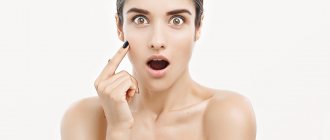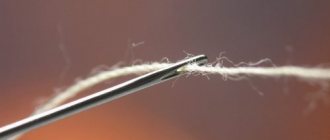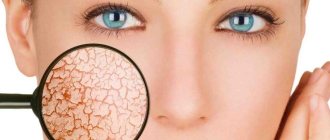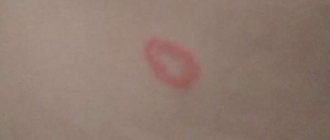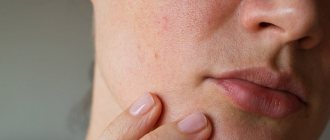White dots (pimples, spots, bumps) that appear on the face and in the eye area are called millet due to their external resemblance to millet grains. The scientific name for this skin problem is milia.
Milia appear as small white balls under the surface of the skin. They are painless, have a dense consistency and do not change their size for quite a long time.
Such formations do not pose a danger to the body, are not a sign of any disease, etc. This is just one of the types of acne that can be easily treated by a cosmetologist.
What are milia?
A small formation in the place where hair begins to grow is called millet. These are dense nodules that are localized mainly on the face in areas with thin skin. They are painless, not prone to growth and inflammation. Their diameter ranges from 0.5 to 3 mm. Rarely, milia can appear on the body or in the groin area. Age category - any, but most often millet is observed in women, newborns and adolescents.
Exocrine glands are located in the dermis, their ducts are often directed to the mouth of the root part of the hair. Each of them secretes sebum, a fatty substance that is a lipid complex.
When released onto the surface of the dermis, the secretion forms a special invisible film, which consists of water and lipids, and is intended for protective functions. In addition, dead epidermal cells are shed through the base of the follicle. When the gland becomes clogged with sebum and horny scales, milia are formed. The formation is called millet because of its similarity to millet grain and its color (white, yellowish).
How does acne develop?66
Problematic skin is most often characterized by increased oiliness. The skin texture becomes uneven, roughness appears, and the mouths of the follicles expand. Staphylococci and propionibacteria located on the surface of the skin produce endogenous lipase, which breaks down triglycerides of sebum (sebum) into free fatty acids. They irritate the skin, causing the appearance of comedones.
If treatment is not started at this stage, the number of comedones will increase, the inflammatory reaction will worsen, and acne will take an indurative form. It is characterized by the appearance of large inflammatory infiltrates.
As a rule, it takes a few more weeks for the infiltrate to soften, the acne elements to open and cavities filled with purulent content to form. After such a rash heals, noticeable scars often remain.
With severe acne, acne conglobata may appear. These are large nodes on the face, back, chest, which are located in the deep layers of the skin, sometimes affecting the upper sections of the subcutaneous fatty tissue. The nodes, the size of which can be 1.5-2 cm, are painful; they cause patients not only aesthetic, but also physical discomfort.
When nodes merge, conglomerates are formed, and abscesses sometimes develop. After opening them, ulcers appear that do not heal for a long time. Over time, rough scars with fistula tracts remain in their place.
When inflammatory nodes immersed in the deep layers of the skin merge, sinus acne can develop. This form is characterized by the formation of epithelial sinus tracts.
Reasons for appearance
Whiteheads can be primary or secondary. In the first case, their appearance is associated with hyperfunction of the sebaceous glands and insufficiency of lipid synthesis. Depending on age and other characteristics, several reasons for the formation of primary retention cysts can be identified:
- In newborns. Sebaceous glands form in the third month of fetal development. In case of disruption of sebum regulation and separation of keratinized particles, millet appears. As a rule, after 1 – 2 weeks, a child’s whiteheads disappear on their own.
- Increased function of the alveolar glands and changes in the chemical composition of sebum - oily seborrhea, which is the source of the development of whiteheads. This disease is also characterized by other types of acne - black, vulgar, atheroma.
- Hormonal imbalance with increased androgen levels. All diseases associated with hormones can lead to the formation of milia - pathologies of the endocrine, reproductive system, adrenal glands, pancreas, and gastrointestinal tract.
- Hyperkeratosis is a disease caused by a lack of vitamin A, environmental problems, work in hazardous industries, and intoxication. Characterized by thickening of the stratum corneum of the epidermis.
- Metabolic disorder. Whiteheads appear due to excess weight and non-compliance with the principles of a healthy diet.
- Lack of hygiene and selection of low-quality cosmetics. Caring for oily skin has its own characteristics. If you do not follow the rules, retention cysts may appear.
Secondary causes of millet formation are frequent stress and a sedentary lifestyle. It can also develop against the background of trauma and inflammatory processes of the skin, chronic diseases of the epidermis, for example, mechanobullous disease, lupus, sarcoidosis, and so on.
Pimples on the penis in a child
This alarming symptom in a child may indicate simple heat rash. During the hot season, due to increased sweating, children's delicate skin becomes irritated, causing small pimples to appear.
A more dangerous cause is intestinal mycosis. This manifestation is also characteristic of a very contagious disease - frequency. Only a doctor can identify the specific cause, so first of all the child must be shown to a specialist.
When should you see a doctor for treatment?
In most cases, millet is harmless and only causes aesthetic inconvenience. Acne forms gradually, without discomfort or inflammation. They can be observed in the form of individual nodules, but more often they are a scattering localized on the eyelids, temples, and in the T-zone. Since the cysts are tightly sealed and have no contact with the environment, they maintain their size. But if the integrity is violated and pathogenic microorganisms enter, inflammation with pustules can develop.
Milium is easily recognized visually by a cosmetologist. But in some cases it needs to be differentiated from fibroma, flat xanthoma, or hamartoma of the eyelids.
Preventing rashes
In order to protect yourself from the occurrence of rashes on the penis, you should adhere to a number of rules:
● it is very important to observe the rules of personal hygiene, take a shower periodically, use exclusively personal hygiene items, and change your underwear frequently;
● avoid diaper rash and sweat accumulation in the groin;
● select suitable underwear;
● use special moisturizing creams, avoid dryness of the groin area;
● when visiting public saunas, baths, swimming pools, gyms, try to minimize contact with common objects and go only to places where a sufficient level of sanitation is maintained;
● exclude promiscuity and use barrier contraception;
● lead a healthy lifestyle, eliminate bad habits, eat a balanced diet;
● regularly undergo preventive examinations for diseases and infections.
How to get rid of milia on the face using cosmetic methods?
There are several ways to remove millet on the skin:
- Mechanical. The instrumental method involves opening the capsule - a puncture using a Vidal needle. The doctor removes the shell, then takes out the keratin contents with a Uno spoon. In this way, the blackhead is removed while preventing the appearance of new nodules.
- Electrocoagulation. A special monopolar mode is used, which allows the eel capsule to be removed using broadband electric current generated radio waves. The nodule dries out and falls off. The method is not recommended if you are prone to the formation of keloid scars.
- Laser removal of milia on the face. Due to the penetration of the energy beam into the layer of the dermis where the capsule is located, it is opened and burned out. The method is painless and is used for multiple foci of millet grass.
- Cryotherapy. Burning with liquid nitrogen. The technique is suitable for single formations.
No more than 10 nodules can be removed at a time. A crust forms at the site of exposure, which disappears after a maximum of 2 weeks. Under no circumstances should you rip it off yourself.
Regardless of the method of removing millet, it is recommended to first undergo a chemical peeling procedure. This technique allows you to get rid of dead scales of the epidermis. Small acne can be removed, while preventing the appearance of new formations.
Treatment of milia
Milia do not go away on their own; it is almost impossible to get rid of them with the help of cosmetics. Under no circumstances should you squeeze out milia yourself, as this will damage the hair follicle and sebaceous gland. Such self-medication often leads to the subsequent formation of a larger acne or the addition of an infection, which can cause the formation of a rough scar.
Treatment of milia is carried out by a dermatologist and consists of opening and removing the cyst capsule with its contents. The choice of removal method depends on the location, number, size and depth of the milia. For single milia, mechanical removal is carried out (using a sterile needle and curettage) with preliminary and subsequent antiseptic treatment of the skin. Small wounds left after such a procedure heal on their own without leaving a trace.
For multiple whiteheads, modern methods are used - removal of milia with a laser, radio wave method or electrocoagulation. The crusts formed at the cauterization site disappear on their own within 10-14 days. Removing more than 10 elements at one time is not recommended to avoid significant trauma to the skin and disruption of the sebaceous glands.
Is it possible to remove milia at home?
Carrying out the procedure for eliminating millet on your own is excluded. Squeezing, scraping, picking out the nodule can lead to an inflammatory process. When an infection occurs, atheroma, fibroma, and so on form in place of the usual harmless millet.
In addition, after self-removal, a scar or scar may form, which is much more difficult to get rid of. The only thing that can be done at home is peeling and scrubbing, but only on the recommendation of a cosmetologist and with suitable means.
Preventing the appearance of milia on the face
Measures to prevent the formation of whiteheads on the skin:
- proper and regular hygiene;
- routine examinations with specialized doctors;
- proper nutrition;
- active lifestyle;
- maintaining mental health;
- proper skin care;
- use of high-quality cosmetics and care products intended for a specific skin type;
- using skin protection from ultraviolet radiation with SPF cream (index 30-50 depending on the time of year).
As a preventative measure, you can prepare your own mild cleansing products:
- Soap and soda. Mix the two components and apply exclusively to the areas where whiteheads form.
- Sour cream or curdled milk with raw pumpkin, crushed into pulp. This product also improves skin color and provides freshness.
- Herbal infusions. Pharmacy chamomile and calendula are suitable. You can use herbs separately, but it is better to make a mixture in a ratio of 1 to The product eliminates inflammation, cleanses and refreshes the skin.
- Crushed oatmeal flakes mixed with cranberries, lemon, sour cream or sea salt.
After peeling, be sure to thoroughly moisturize the skin and apply a nourishing cream. The procedure can be performed no more than 2 times a week.
Diagnosis of pearly papules
The diagnosis is made based on a clinical examination by a urologist or dermatovenerologist. If the change is accompanied by symptoms of inflammation - redness, swelling and itching - another etiology should be considered.
They are often confused with condylomas (genital warts), which are sexually transmitted diseases caused by HPV infection. The misconception can be easily eliminated with the help of a biopsy and microscopic examination of this change - a different number of dilated thin-walled blood vessels, proliferation of fibroblast cells and connective tissue are observed.
How to care for oily skin?
Since milia are mainly characteristic of the dermis, which is prone to excessive sebum production, proper care will help prevent their formation. Recommendations for caring for oily skin:
- Cleansing. It must be carried out in such a way that the protective barrier of the skin is not damaged. Products with mild formulas will help get rid of excess fat, but will not upset the balance. It is not recommended to use regular soap for cleansing; formulations in the form of foam or gel are more suitable. Products may contain calendula, chamomile, aloe, and hyaluronic acid. The main thing is to always remove makeup before going to bed.
- Toning. Helps restore acid-base balance and eliminate the effects of environmental exposure. Tonics against blackheads, millet and oily shine mattify well, gently cleanse the skin, moisturize and refresh. They never contain alcohol and contain thermal water and other components.
- Exfoliation. Oily skin needs a scrub that provides a drying, soothing, cleansing effect. The procedure is aimed at eliminating keratinized scales.
- Hydration. In formulas for oily skin, the ratio of components is more water, less oil. These are light cream textures with a matting effect.
Getting rid of milia is not difficult, but this procedure should be entrusted to a professional cosmetologist. You can independently carry out only preventive measures aimed at preventing the formation of millet grass.
